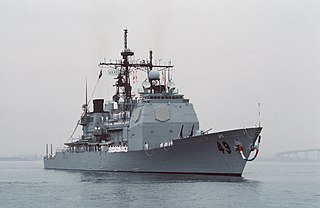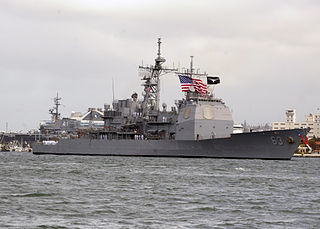
USS Port Royal (CG-73) was a Ticonderoga-class guided missile cruiser that served in the United States Navy. She was commissioned on 9 July 1994, as the 27th and final ship of the class. Port Royal was named in honor of the two naval battles of Port Royal Sound, South Carolina, one during the American Revolutionary War, the other during the American Civil War. She was decommissioned on 29 September 2022. The ship is the second to bear the name, with the first being a steam-powered, side-wheel gunboat, from New York City, in commission from 1862 to 1866.

USS Vincennes (CG-49) was a Ticonderoga-class guided missile cruiser outfitted with the Aegis combat system that was in service with the United States Navy from July 1985 to June 2005. She was one of 27 ships of the Ticonderoga class constructed for the United States Navy and one of five equipped with the Mark 26 Guided Missile Launching System.

USS Dale (DLG-19/CG-19) was a Leahy-class cruiser in service with the United States Navy from 1963 to 1994. She was sunk as a target in 2000 off the East Coast of the United States near Maryland.

USS Antietam (CG-54) is a Ticonderoga-class guided missile cruiser of the United States Navy. Antietam was named for the site of the 1862 Battle of Antietam, Maryland, between Confederate forces under General Robert E. Lee and Union forces under Major General George McClellan, during the American Civil War. Antietam earned the 2007 and 2008 Battle Efficiency awards, also known as the "Navy E" or "Battle E" award, for the John C. Stennis Strike Group.

USS Bunker Hill (CG-52) is a Ticonderoga-class guided missile cruiser of the United States Navy constructed by Litton-Ingalls Shipbuilding Corporation at Pascagoula, Mississippi and launched on 11 March 1985. The Ticonderoga-class cruisers are equipped with the Aegis Combat System and Bunker Hill is the first of the class to be equipped with the Mark 41 Vertical Launching System (VLS) in place of the previous ships' twin-arm Mark 26 missile launchers, which greatly improved the flexibility and firepower of the ships by allowing them to fire BGM-109 Tomahawk cruise missiles for land attack missions. Other missions include ballistic missile defence and capital ship escort for anti-aircraft defense. The ship was commissioned on 20 September 1986 and is homeported at Naval Base San Diego in San Diego, California.

USS Barry (DDG-52) is an Arleigh Burke-class guided missile destroyer, commissioned in 1992. Barry is the fourth United States Navy ship named after the "Father of the American Navy", Commodore John Barry (1745–1803). Her homeport is Naval Station Everett, Washington. Several improvements over Arleigh Burke exist on this ship and all following Arleigh Burke-class destroyers, such as the ability to refuel a helicopter.

USS Vella Gulf (CG-72) is a Ticonderoga-class guided missile cruiser that served with the United States Navy. She was the second ship named for the Battle of Vella Gulf, a naval engagement in the Solomons campaign of World War II, the first being USS Vella Gulf (CVE-111), an escort carrier commissioned in 1945. The ship's keel was laid down on 22 April 1991 at Pascagoula, Mississippi, by Ingalls Shipbuilding, then a division of Litton Industries. She was launched on 13 June 1992, sponsored by Mary A. McCauley, wife of Vice Admiral William F. McCauley (Ret.), and commissioned on 18 September 1993 at Naval Station Norfolk.

USS Yorktown (DDG-48/CG-48) was a Ticonderoga-class cruiser in the United States Navy from 1984 to 2004, named for the American Revolutionary War Battle of Yorktown.

The Ticonderoga class of guided-missile cruisers is a class of warships in the United States Navy, first ordered and authorized in the 1978 fiscal year. The class uses passive phased-array radar and was originally planned as a class of destroyers. However, the increased combat capability offered by the Aegis Combat System and the AN/SPY-1 radar system, together with the capability of operating as a flagship, were used to justify the change of the classification from DDG to CG shortly before the keels were laid down for Ticonderoga and Yorktown.

USS Valley Forge (CG-50) was a Ticonderoga-class cruiser in the United States Navy. She was named for Valley Forge, where the Continental Army camped during one winter in the American Revolution.

USS Thomas S. Gates (CG-51) was a flight-I Ticonderoga-class cruiser that was used by the United States Navy. The warship was named after Thomas S. Gates, Secretary of Defense in the last years of the Eisenhower Administration (1959–1961).

USS Mobile Bay (CG-53) is a Ticonderoga class guided-missile cruiser serving in the United States Navy. She is named for the naval Battle of Mobile Bay during the American Civil War in 1864.

USS San Jacinto (CG-56) is a Ticonderoga-class cruiser in the United States Navy. She is named for the Battle of San Jacinto, the decisive battle of the Texas Revolution.

USS Princeton (CG-59) is a Ticonderoga-class guided missile cruiser serving in the United States Navy. Armed with naval guns and anti-air, anti-surface, and anti-submarine missiles, plus other weapons, she is equipped for surface-to-air, surface-to-surface, and anti-submarine warfare. She was previously home to two SH-60B LAMPS Mk III Seahawk helicopters and now carries a pair of the MH-60R version of the Seahawk. This warship is named for the Revolutionary War victories over the British by George Washington in and around the town of Princeton, New Jersey.

USS Cowpens (CG-63) is a Ticonderoga-class guided missile cruiser in service with the United States Navy. The ship is named after the Battle of Cowpens, a major American victory near Cowpens, South Carolina, in the American Revolution. She was built at the Bath Iron Works in Maine. Cowpens is stationed at Naval Base San Diego.

USS Vicksburg (CG-69) is a Ticonderoga-class guided missile cruiser serving in the United States Navy. She is named for the Siege of Vicksburg fought during the American Civil War.

USS Lake Erie (CG-70) is a Ticonderoga-class guided missile cruiser of the United States Navy, commissioned in 1993. She was named after the U.S. Navy's decisive victory in the Battle of Lake Erie during the War of 1812. The cruiser was the first U.S. Navy ship to be commissioned in Hawaii.

USS California (CGN-36), the lead ship of the California-class of nuclear-powered guided missile cruisers, was the sixth warship of the United States Navy to be named for the State of California.

USS Fox (DLG-33/CG-33) was a Belknap class cruiser of the United States Navy, named after Gustavus V. Fox, President Abraham Lincoln's Assistant Secretary of the Navy. The keel for DLG-33 was authenticated and laid in ceremonies at Todd Shipyards, Los Angeles Division, San Pedro, California on 15 January 1963.

USS Richmond K. Turner was a Leahy-class cruiser destroyer leader in the United States Navy. The ship was named for Admiral Richmond K. Turner, who served during World War II.




















